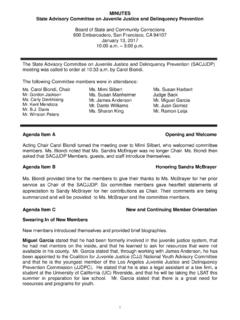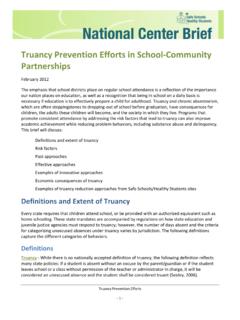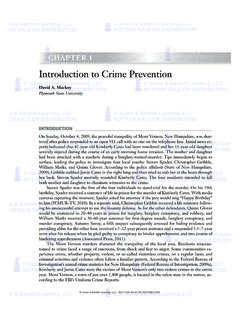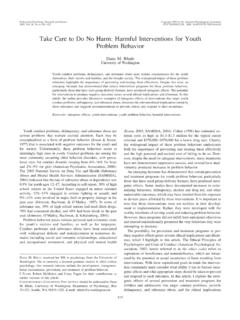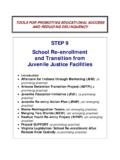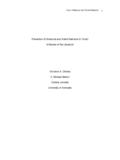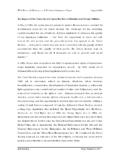Transcription of NVESTIGATING HATE RIMES ON THE
1 TE C H N I C A LAS S I S TA N C EBR I E FINVESTIGATINGHATECRIMESONTHEINTERNETP artners Aganst HateFunded by the Department of Justice, Office of Juvenile Justice andDelinquency prevention and the Department of Education, Safe andDrug-Free Schools ProgramPartners Against HateOffice of Juvenile Justice andSafe and Drug-Free Schools c/o Anti-Defamation LeagueDelinquency PreventionProgram1100 Connecticut Avenue, Department of Department of EducationSuite 1020810 Seventh Street, NW400 Maryland Avenue, SWWashington, DC 20036 Washington, DC 20531 Washington, DC WotorsonProject DirectorThis project was produced by Partners Against Hate under Cooperative Agreement #2000-JN-FX-K005, a grant jointly funded by Department of Justice, Office of Juvenile Justice and delinquency prevention (OJJDP), and the Department of Education,Safe and Drug-Free Schools Program.
2 This document was prepared by the Center for the prevention of Hate Violence. Points ofview or opinions expressed in this document are those of the authors and do not necessarily represent the official positions orpolicies of the Department of Justice, Office of Juvenile Justice and delinquency prevention or the Department ofEducation, Safe and Drug-Free Schools the time of this publication s printing, all Web site addresses were accurate and provided material that was, in the judgment ofPartners Against Hate staff, appropriate for all audiences. Partners Against Hate is not responsible for future changes to any Websites and does not endorse any Web sites identified other than its Against Hate is a collaboration of the Anti-Defamation League, the Leadership Conference on CivilRights Education Fund, and the Center for the prevention of Hate by James E. Kaplan, J. Margaret P. Moss, J. for the prevention of Hate ViolenceUniversity of Southern MaineEdited by Michael L.
3 Lieberman, Anti-Defamation Leagueand Stephen Wessler, Center for the prevention of Hate ViolenceTABLEOFCONTENTSivPartners Against .. Bias-Motivated Crimes: A Law Enforcement Priority ..7 Hate Crimes and Bias Incidents ..7 Reported Cases: Hate Crimes on the Internet ..8 Reasons for Likely Increase in Internet Hate Crimes .. hate crimes on the Internet ..10 Determining Whether a Message Constitutes a Threat ..10 Bias Motivation: The Importance of Bias Crime Indicators ..10 Identifying the Sender ..11 Collection and Preservation of Evidence .. Issues ..12 Hate Web Sites ..12 Jurisdiction .. : Bias Crime Indicators ..17 VIII. References .. Hate Crimes on the Internet5 All Americans have a stake in effective response to hatecrimes. These crimes demand priority attention becauseof their special impact. Bias crimes are designed tointimidate the victim and members of the victim scommunity, leaving them feeling isolated, vulnerable,and unprotected by the law.
4 Failure to address thisunique type of crime could cause an isolated incident toexplode into widespread community tension. Thedamage done by hate crimes, therefore, cannot bemeasured solely in terms of physical injury or dollars andcents. By making members of targeted communitiesfearful, angry, and suspicious of other groups -- and ofthe power structure that is supposed to protect them --hate crimes can damage the fabric of our society andfragment Internet has rapidly transformed the way peopleworldwide communicate messages and ideas, dobusiness, and live their lives. The ability to sendinformation instantaneously at any time for relativelylittle or no cost is truly revolutionary. As the Internet simportant and significant benefits expand, however, thepossibilities to use this medium for unlawful activity growas well. Unfortunately, the Internet has become a newfrontier in spreading hate. The Internet is an especially inviting host for the virus ofhate.
5 Whereas hate mongers once had to stand on streetcorners and hand out their message of bigotry onmimeographed leaflets, now these extremists have seizednew technologies to promote their causes at sites on theWorld Wide Web and in chat rooms. The Internet hasallowed extremists expanded access to a potentialaudience of millions including impressionable youth. Ithas also facilitated communication among like-mindedbigots across borders and oceans and enhances theirability to promote and recruit for their causesanonymously and cheaply. In a criminal context, e-mailmessages containing threats can be sent behind a cloakof anonymity or false identity. Persons can be chosen toreceive messages without their consent or hate speech is offensive and hurtful, the FirstAmendment usually protects such expression. Beyondspreading hate, however, there is a growing, disturbingtrend to use the Internet to intimidate and harassindividuals on the basis of their race, religion, sexualorientation, or national origin.
6 When speech contains adirect, credible threat against an identifiable individual,organization, or institution, it crosses the line to criminalconduct. Hate speech containing criminal threats isnot protected by the First casesconcerning hate speech on the Internet have, to date,been few in number. The Internet is vast andperpetrators of online hate crimes hide behindanonymous screen names, electronically garbledaddresses, and Web sites that can be relocated andabandoned overnight. Despite these special challenges,law enforcement authorities can learn much from thefirst few successful prosecutions outlined in thisTechnical Assistance States v. MachadoIn September 1996, a 21-year-old expelled college studentwho lived in Southern California sent a threatening e-mailmessage to 60 Asian students at the University of CaliforniaIrvine ( UC Irvine ). The message expressed a hatred forAsians and stated that UC Irvine would be a much morepopular school without Asian students.
7 The messagefurther blamed Asians for all crimes that occurred oncampus, and concluded with a clear threat to hunt downand kill all Asians on campus if they did not leave theuniversity: I personally will make it my life career [sic] tofind and kill everyone one [sic] of you That s how determined I The message was signed Asian Hater. The sender did not sign his name to the message, and themessage was sent from an e-mail account that hid hisidentity. Ultimately, however, in voluntary interviews withUC Irvine police, Richard Machado admitted that he sentthe threatening message. He was charged with violatingthe Federal Civil Rights laws, which prohibits (among otherthings) interference by force or threat of force based onrace or national origin with a person s attendance at apublic Against HateThe urgent national need for both a tough lawenforcement response to hate crimes, and education andprogramming, to confront violent bigotry has onlyincreased over the past year.
8 In the aftermath of theSeptember 11, 2001, terrorism, the nation has witnesseda disturbing increase in attacks against American citizensand others who appear to be of Muslim, Middle Eastern,and South Asian descent. Perhaps acting out of anger atthe terrorists involved in the September 11, 2001attacks, the perpetrators of these crimes are irrationallylashing out at innocent people because of their personalcharacteristics their race, religion, or ethnicity. Lawenforcement officials have investigated hundreds ofincidents reported from coast to coast places ofworship, neighborhood centers, grocery stores, gasstations, restaurants, and homes including vandalism,intimidation, assaults, and several Brief provides essential information about thegrowing problem of hate crimes on the Internet and tipsfor investigation and prosecution of hate crimes on theInternet. First, the Brief defines hate crimes,summarizes the principal Federal and State hate crimelaws, and describes a number of reported cases.
9 Second,the Brief examines key legal elements involved in theinvestigation of hate crimes on the Internet. Finally, theBrief focuses on three issues that can arise in hate crimeinvestigations, including First Amendment protections forhate Web sites, the jurisdictional aspects of prosecutionof threats on the Internet, and potential problemsencountered in the collection and preservation ofelectronic States v. Machado (cont.)Machado s first trial ended in a hung jury. A second trial in1998 resulted in Machado s conviction, and he wassentenced to one year in : A LAWENFORCEMENTPRIORITYI NVESTIGATING Hate Crimes on the Internet7 Hate Crimes and Bias IncidentsThe Federal government defines a hate crimeas acrime in which the defendant selects a victim, or in thecase of a property crime, the property that is the objectof the crime, because of the actual or perceived race,color, religion, national origin, ethnicity, gender,disability, or sexual orientation of any person.
10 28 994, as hate crime penaltyenhancement statutes that now exist in 45 states and theDistrict of Columbia, this law increases sentences forbias-motivated federal crimes. With respect to theInternet, a hate crime is almost always a incidentis an act that is motivated by bias orprejudice that does not involve criminal conduct. Forexample, the distribution of hate literature is a biasincident. The definition of what constitutes a hate crimevaries from state to state and under Federal law. Hatecrime offenders may be prosecuted under Federal orstate criminal and civil rights laws. Participants in biasincidents cannot be prosecuted criminally, but state lawmay provide a civil Laws Federal Criminal Civil RightsStatutesState and local law enforcement authorities play theprimary role in the prosecution of bias-motivatedviolence. Current Federal law contains significant gapsand limitations, reaching only certain bias-motivatedviolence, which is intended to interfere with the victim sfederal rights or participation in a federally protectedactivity.




